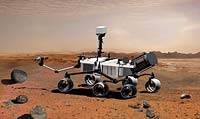
Mars Science Laboratory (MSL)
NASA Mars RoverCourtesy of NASA's National Space Science Data Center
Launch Date/Time: 2011-11-26 15:02 UT (10:52 a.m. EST)
Mass: 750 kg
Launch Vehicle:Atlas V
Launch Site:Cape Canaveral, United States
Description
The Mars Science Laboratory (MSL), nicknamed Curiosity, is a large rover with the objective of exploring the martian environment as a former or current habitat for life. The mission is planned to operate on Mars over at least a full martian year (687 Earth days). The rover has eight science objectives: 1) determine the nature and inventory of organic carbon compounds; 2) inventory the chemical building blocks of life; 3) identify features that may represent the effects of biological processes; 4) investigate the chemical, isotopic, and mineralogical composition of the martian surface and near-surface geological materials; 5) interpret the processes that have formed and modified rocks and soils; 6) assess long-timescale (i.e. 4-billion-year) atmospheric evolution processes; 7) determine the present state, distribution, and cycling of water and carbon dioxide; and 8) characterize the broad spectrum of surface radiation, including galactic cosmic radiation, solar proton events, and secondary neutrons.
Spacecraft and Subsystems
The rover is a six wheeled vehicle approximately 2.8 meters in length with a mass of over 750 kg. The main rover body is a warm electronics box (WEB) which houses the electronics and computer. Mounted on top of the WEB is a triangular Rover Equipment Deck, on which is mounted a mast, cameras, and other scientific equipment. A robot arm with sample collection devices and scientific instruments is also mounted on the rover. The six wheels are mounted on a rocker-bogie suspension. The two front and two rear wheels have individual steering motors. Top speed of the rover is about 4 cm per second. Power is provided by a radioisotope thermoelectric generator (RTG) which produces 125 W at the start of the mission. Thermal control is achieved by a system of tubes, with heating provided by excess heat from equipment and the RTG. The rover is equipped with four hazard avoidance cameras, two navigation cameras, and a science stereo camera mounted on the mast. There is also a descent imager designed to take images of the lading site before touchdown. Other scientific instruments on the MSL include the Sample Analysis at Mars (SAM) Instrument Suite, the MArs Hand Lens Imager (MAHLI), Alpha Particle X-Ray Spectrometer (APXS), Chemistry & Camera (ChemCam), Chemistry & Mineralogy X-Ray Diffraction/X-Ray Fluorescence Instrument (CheMin), the Radiation Assessment Detector (RAD), the Dynamic Albedo of Neutrons (DAN) experiment, the Rover Environmental Monitoring Station (REMS), and the Mars Science Laboratory Entry Descent and Landing Instrument (MEDLI).
Mission Profile
Mars Science Laboratory launched on 26 November 2011 at 15:02 UT (10:52 a.m. EST) on an Atlas V 541 into a circular Earth parking orbit. After leaving Earth orbit and completing an 8 month cruise, MSL reached Mars in August 2012. The entry phase began at an altitude of 125 km with the MSL enclosed in an aeroshell and heat shield. Following a series of S-curve manuevers to slow its descent, about three minutes before touchdown a parachute was deployed. Retrorockets were used in the final phase of the descent, ending with the rover being lowered to the surface from the descent stage on a tether. Touchdown occured at 05:32 UTC (1:32 EDT) on 6 August. After a checkout period, the rover made its first drive on 22 August. Over the nominal one martian year (687 Earth day) period, the rover will travel 5 to 20 km and collect and analyze roughly 70 rock and soil samples. The landing site in Gale Crater was chosen for its potential as a former or current habitat for life.
 Mars Science Laboratory with Power Source and Extended Arm, Artist's Concept
Mars Science Laboratory with Power Source and Extended Arm, Artist's Concept
NASA's Mars Science Laboratory, a mobile robot for investigating Mars' past or present ability to sustain microbial life, is in development for a launch opportunity in 2011 (previously 2009).. This picture is an artist's concept portraying what the advanced rover would look like in Martian terrain, from a side aft angle.
The arm extending from the front of the rover is designed both to position some of the rover's instruments onto selected rocks or soil targets and also to collect samples for analysis by other instruments. Near the base of the arm is a sample preparation and handling system designed to grind samples, such as rock cores or small pebbles, and distribute the material to analytical instruments.
The mast, rising to about 2.1 meters (6.9 feet) above ground level, supports two remote-sensing instruments: the Mast Camera for stereo color viewing of surrounding terrain and material collected by the arm, and the ChemCam for analyzing the types of atoms in material that laser pulses have vaporized from rocks or soil targets up to about 9 meters (30 feet) away.
(Courtesy NASA/JPL-Caltech)
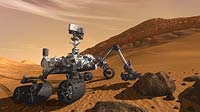 Curiosity: The Next Mars Rover (Artist's Concept)
Curiosity: The Next Mars Rover (Artist's Concept)
This artist concept features NASA's Mars Science Laboratory Curiosity rover, a mobile robot for investigating Mars' past or present ability to sustain microbial life. Curiosity is being tested in preparation for launch in the fall of 2011. In this picture, the rover examines a rock on Mars with a set of tools at the end of the rover's arm, which extends about 2 meters (7 feet). Two instruments on the arm can study rocks up close. Also, a drill can collect sample material from inside of rocks and a scoop can pick up samples of soil. The arm can sieve the samples and deliver fine powder to instruments inside the rover for thorough analysis.
The mast, or rover's "head," rises to about 2.1 meters (6.9 feet) above ground level, about as tall as a basketball player. This mast supports two remote-sensing instruments: the Mast Camera, or "eyes," for stereo color viewing of surrounding terrain and material collected by the arm; and, the ChemCam instrument, which is a laser that vaporizes material from rocks up to about 9 meters (30 feet) away and determines what elements the rocks are made of.
(Courtesy NASA/JPL-Caltech)
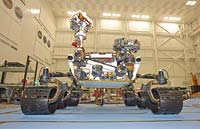 Mars Rover Curiosity, Front View
Mars Rover Curiosity, Front View
This photograph of the NASA Mars Science Laboratory rover, Curiosity, was taken during mobility testing on June 3, 2011. The location is inside the Spacecraft Assembly Facility at NASA's Jet Propulsion Laboratory, Pasadena, Calif.
(Courtesy NASA/JPL-Caltech)
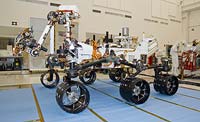 Mars Rover Curiosity, Left Side View
Mars Rover Curiosity, Left Side View
A Russian-built, neutron-shooting instrument on the Curiosity rover of NASA's Mars Science Laboratory mission will check for water-bearing minerals in the ground beneath the rover.
The instrument, named Dynamic Albedo of Neutrons, or DAN, has two major components: the pulsed neutron generator on the starboard side of the rover, and the detector and electronics module on the port side (location indicated by red outline). The pulsed neutron generator will shoot high-energy neutrons into the ground. If there is hydrogen in the shallow subsurface, the injected neutrons will bounce off the hydrogen atoms with a characteristic decrease in energy. Two detection devices in the detector and electronics module measure the rate and delay time of the reflected neutrons, yielding information about the amount and depth of any hydrogen. At the mission's near-equatorial landing area and in the oxidizing environment near the Martian surface, most hydrogen is expected to be in the form of water molecules or water-derived hydroxyl ions bound to minerals.
(Courtesy NASA/JPL-Caltech)
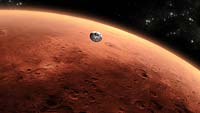 Curiosity Approaching Mars, Artist's Concept
Curiosity Approaching Mars, Artist's Concept
This is an artist's concept of NASA's Mars Science Laboratory spacecraft approaching Mars.
The Curiosity rover is safely tucked inside the spacecraft's aeroshell. The mission's approach phase begins 45 minutes before the spacecraft enters the Martian atmosphere. It lasts until the spacecraft enters the atmosphere. For navigation purposes, the atmospheric entry point is (2,188 miles (3,522 kilometers) above the center of the planet. This illustration depicts a scene after the spacecraft's cruise stage has been jettisoned, which will occur 10 minutes before atmospheric entry.
(Courtesy NASA/JPL-Caltech)
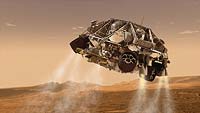 Curiosity and Descent Stage, Artist's Concept
Curiosity and Descent Stage, Artist's Concept
This is an artist's concept of the rover and descent stage for NASA's Mars Science Laboratory spacecraft during the final minute before the rover, Curiosity, touches down on the surface of Mars.
The descent stage will provide rocket-powered deceleration for a phase of the arrival at Mars after the phases using the heat shield and parachute. The descent stage also carries the radar system providing a stream of information about the spacecraft's altitude and velocity. As it nears the surface, shortly after the moment depicted here, the descent stage will lower the rover on a bridle and deliver it to the ground.
(Courtesy NASA/JPL-Caltech)
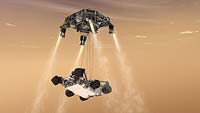 Curiosity's Sky Crane Maneuver, Artist's Concept
Curiosity's Sky Crane Maneuver, Artist's Concept
This artist's concept shows the sky crane maneuver during the descent of NASA's Curiosity rover to the Martian surface.
The entry, descent, and landing (EDL) phase of the Mars Science Laboratory mission begins when the spacecraft reaches the Martian atmosphere, about 81 miles (131 kilometers) above the surface of the Gale crater landing area, and ends with the rover Curiosity safe and sound on the surface of Mars.
Entry, descent, and landing for the Mars Science Laboratory mission will include a combination of technologies inherited from past NASA Mars missions, as well as exciting new technologies. Instead of the familiar airbag landing systems of the past Mars missions, Mars Science Laboratory will use a guided entry and a sky crane touchdown system to land the hyper-capable, massive rover.
The sheer size of the Mars Science Laboratory rover (over one ton, or 900 kilograms) would preclude it from taking advantage of an airbag-assisted landing. Instead, the Mars Science Laboratory will use the sky crane touchdown system, which will be capable of delivering a much larger rover onto the surface. It will place the rover on its wheels, ready to begin its mission after thorough post-landing checkouts.
The new entry, descent and landing architecture, with its use of guided entry, will allow for more precision. Where the Mars Exploration Rovers could have landed anywhere within their respective 93-mile by 12-mile (150 by 20 kilometer) landing ellipses, Mars Science Laboratory will land within a 12-mile (20-kilometer) ellipse! This high-precision delivery will open up more areas of Mars for exploration and potentially allow scientists to roam "virtually" where they have not been able to before.
In the depicted scene, the spacecraft's descent stage, while controlling its own rate of descent with four of its eight throttle-controllable rocket engines, has begun lowering Curiosity on a bridle. The rover is connected to the descent stage by three nylon tethers and by an umbilical providing a power and communication connection. The bridle will extend to full length, about 25 feet (7.5 meters), as the descent stage continues descending. Seconds later, when touchdown is detected, the bridle is cut at the rover end, and the descent stage flies off to stay clear of the landing site.
(Courtesy NASA/JPL-Caltech)
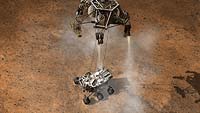 Curiosity Touching Down, Artist's Concept
Curiosity Touching Down, Artist's Concept
This artist's concept depicts the moment that NASA's Curiosity rover touches down onto the Martian surface.
The entry, descent, and landing (EDL) phase of the Mars Science Laboratory mission begins when the spacecraft reaches the Martian atmosphere, about 81 miles (131 kilometers) above the surface of the Gale crater landing area, and ends with the rover safe and sound on the surface of Mars.
Entry, descent, and landing for the Mars Science Laboratory mission will include a combination of technologies inherited from past NASA Mars missions, as well as exciting new technologies. Instead of the familiar airbag landing systems of the past Mars missions, Mars Science Laboratory will use a guided entry and a sky crane touchdown system to land the hyper-capable, massive rover.
The sheer size of the Mars Science Laboratory rover (over one ton, or 900 kilograms) would preclude it from taking advantage of an airbag-assisted landing. Instead, the Mars Science Laboratory will use the sky crane touchdown system, which will be capable of delivering a much larger rover onto the surface. It will place the rover on its wheels, ready to begin its mission after thorough post-landing checkouts.
The new entry, descent and landing architecture, with its use of guided entry, will allow for more precision. Where the Mars Exploration Rovers could have landed anywhere within their respective 93-mile by 12-mile (150 by 20 kilometer) landing ellipses, Mars Science Laboratory will land within a 12-mile (20-kilometer) ellipse! This high-precision delivery will open up more areas of Mars for exploration and potentially allow scientists to roam "virtually" where they have not been able to before.
In the depicted scene, Curiosity is touching down onto the surface, suspended on a bridle beneath the spacecraft's descent stage as that stage controls the rate of descent with four of its eight throttle-controllable rocket engines. The rover is connected to the descent stage by three nylon tethers and by an umbilical providing a power and communication connection. When touchdown is detected, the bridle will be cut at the rover end, and the descent stage flies off to stay clear of the landing site.
(Courtesy NASA/JPL-Caltech)